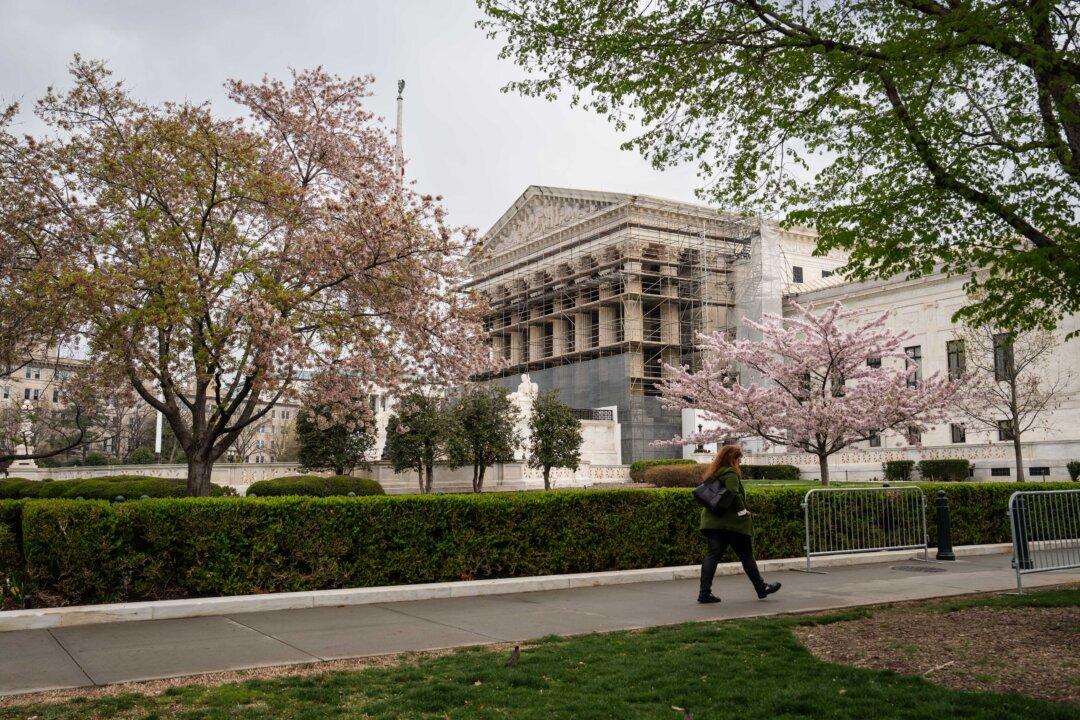The Supreme Court on June 24 reversed a lower court’s ruling against bump stock purchasers after the justices overturned a federal ban on the devices days before.
The regulation, which came into being during the Trump administration after a gunman used bump stock-equipped rifles in a 2017 mass shooting in Las Vegas, had reversed years of Bureau of Alcohol, Tobacco, Firearms, and Explosives (ATF) interpretations on the use of “machine guns.”
Bump stocks were designed for people with limited hand mobility, such as those who suffer from arthritis.
A bump stock replaces a rifle’s standard stock, which is the part of a rifle behind the receiver and grip where a shooter’s cheek is positioned when aiming a rifle. A bump stock doesn’t make any modifications to the firing components of a rifle but makes the continuous rapid fire of the weapon possible. As the non-trigger hand pushes the rifle forward, the trigger “bumps” against the shooter’s stationary trigger finger, causing the trigger to depress and the rifle to shoot again.
In 2018, the ATF issued a regulation that interpreted the term “machine gun” expansively and banned bump stocks for the first time. The agency outlawed bump stocks, finding they qualify as machine guns under federal law.
The National Firearms Act strictly regulates machine guns and imposes a steep tax on their purchase. The Firearm Owners’ Protection Act banned civilian ownership of machine guns manufactured after May 1986, as well as any parts used to convert an otherwise semiautomatic lawful firearm into an illegal machine gun. A semiautomatic gun fires only once with each pull of the trigger, but a fully automatic gun—typically called a machine gun—will continue to fire as long as the trigger is squeezed.
But in Garland v. Cargill, the Supreme Court ruled 6–3 on June 14 that the ATF went beyond its authority when it held that federal law prohibited bump stocks.
“We conclude that [a] semiautomatic rifle equipped with a bump stock is not a ‘machinegun’ because it does not fire more than one shot ‘by a single function of the trigger,’” Justice Clarence Thomas wrote in the court’s majority opinion.
“So now, we have a case that is case law that we can move forward around this country and defend our Second Amendment rights,” Mr. Cargill said.
In the case at hand, Guedes v. ATF, petitioners Damien Guedes and Shane Roden bought bump stocks at a time when ATF publicly confirmed that possession of such devices was lawful. The change in interpretation of the law came after their purchases took place.
In December 2018, the petitioners sued in federal district court, arguing, among other things, that ATF did not have statutory authority to issue a regulation expanding the scope of the machine gun ban.
Both the district court and the U.S. Court of Appeals for the District of Columbia Circuit ruled against them.
In denying their challenge, the two courts relied on the legal doctrine known as Chevron deference, which is currently being challenged in the Supreme Court.
The 40-year-old doctrine holds that an agency’s interpretation of a statute it administers is entitled to deference unless Congress has said otherwise.
In its ruling in Guedes, the circuit court denied the petitioners’ motion to temporarily block the ATF regulation on the grounds that the “statutory definition of ‘machinegun’ is ambiguous and [ATF’s] interpretation” to include bump stocks “is reasonable.”
The ATF’s regulation turned “law-abiding bump-stock owners into criminals. But the Anglo-American legal system has long restricted the executive branch’s power to create new crimes. Crimes are made by legislation, not executive fiat,” the judge wrote.
The agency’s regulation stretched “the text of the National Firearms Act to criminalize conduct that Congress has not,” he added.
On June 24, the Supreme Court justices summarily granted the petition for certiorari, or review, in Guedes v. ATF in an unsigned order. No justices dissented.
At the same time, the justices vacated the decision of the DC Circuit without holding oral arguments. The Supreme Court sent the case back to the circuit court for “further consideration in light of Garland v. Cargill.”
Lawyers call this process GVR, for grant, vacate, and remand.
It is unclear when the DC Circuit will reconsider the case.







